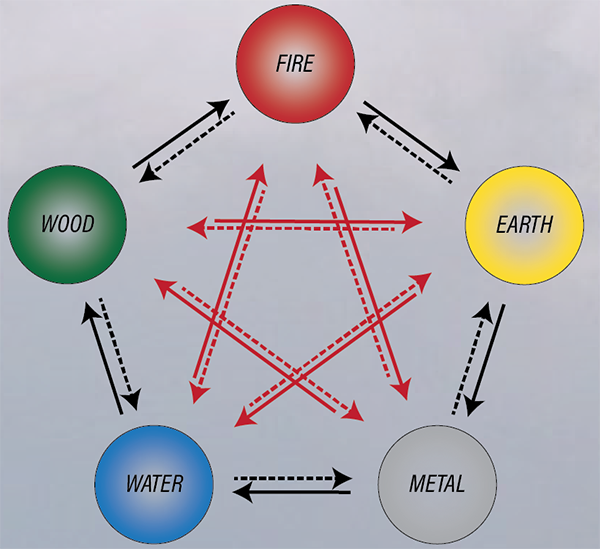
If you are new to qigong, or especially if you have practiced qigong for awhile, you will have probably discovered that while there are many individual qigong movements that can be practiced by themselves – they are often practiced not as single movements, but together as a set of several movements. Perhaps you have wondered why that is, and what the benefit is of practicing a ‘set’ of qigong movements rather than individual movements on their own?
This article will look at four reasons why qigong is often practiced as sets of movements, and some of the relative benefits of practicing both qigong sets and individual movements by themselves. It will then discuss the merits and challenges of creating your own sets or sequences of qigong movements.
Diversity of Qigong Sets
Qigong has been practiced for thousands of years, and over that time it has evolved and developed as its many practitioners and masters have each brought their own individual perspective and focus to working with their energy. Some practitioners have had quite different goals from others, and some have come up with quite different methods of achieving similar goals – while using the same core principles of working with the mind, body, and breath to tap into and direct their energy. This has led to incredible diversity within qigong practice with many thousands of different styles developing.

These different styles sometimes have their own unique movements, but many times make use of similar movements as other styles – but combined together in different ways to achieve their purposes. In some ways you could consider each movement to be an ingredient within the recipe of a qigong practice. The ingredient can be quite useful on its own, and can take on different roles and functions when combined with other ingredients or movements. Different chef’s make use of the same ingredients, and maybe sometimes a few secret ingredients to come up with their famous recipes. Ideally a good recipe becomes more than the sum of its parts – the way all of the ingredients are selected and combined working together synergistically to produce something nourishing, tasty – and in the case of qigong in particular, good for your health.
Four Different Types of Qigong Sets
These sets of movements are created for a range of different purposes. Some common ones are:
1.To systematically activate and balance a system of the body or energy. Some examples of qigong sets designed for this purpose are Twelve Rivers Qigong which balances the organ meridian system, Between Heaven and Earth which balances the extraordinary meridians, Five Waves which gently harmonizes the five elements in the body, or the Yi Jin Jing which activates the muscles and connective tissue throughout the body – and many many more. By working through a series of movements which together activate a complete system, not only does the practitioner naturally bring balance to that system, they also gain a deeper understanding of the functioning of that system in a very practical and experiential way, greatly enhancing their knowledge and ability to be aware of the state of the energy within that system and to work skillfully with it.

Because these qigong sets work through a complete system within them, they are a very safe way to practice – particularly for beginners, as the practices naturally bring balance, and you don’t need to be concerned about overstimulating one part of an energy system or another while practicing this type of qigong set.
2.To explore some principle or character of energy deeply. This type of qigong set does not necessarily work through all the parts of an energy or body system comprehensively, but rather focuses on really exploring and deepening the experience, skill, and understanding of one part or character of our energy – which may be only part of a greater whole system. Some examples of this type of practice could be the different animal practices found within the Wild Animal Play. Practicing all of the animals together will bring balance to the body and energy systems, but we may also often choose to practice just a single animal at a time as a way to go really deep into the physical and energy characteristics of that animal to allow us gain a much deeper understanding and skill with them. If we want to develop more physical strength and passionate determination we might choose to just focus on Tiger qigong practices, or if we want to develop more balance, grace, and precision we might practice Crane qigong by itself to develop these attributes.
Another example of this type of qigong set is elemental qigong practices. There are many sets of qigong practices that work with all five of the elements in sequence to bring them into balance and harmony, but equally there are many practices that focus on just one of the elements at a time to deepen understanding and skill with that element. Each have their place and value. Sometimes our aim is simply to harmonize the whole cycle of elements, and at other times we may have a need to strengthen just one of the elements in particular – in which case practicing a qigong set that focuses just on that element will be more effective and beneficial for us. We might choose a fire element focused set to develop our joy and expressiveness, or an earth element based set to develop and strengthen our stability and nurturing.

A little more care needs to be taken when practicing qigong sets of this nature, so that we do not find ourselves activating one part of our energy system to the extent that in unbalances other parts of the system. But focusing on just one aspect of our energy at a time can help us to remedy specific issues that we may have in a more direct way – by allowing us to spend more time and focus on those specific areas.
3.To cumulatively work towards a specific purpose. Some qigong sets put together different movements and practices which are not necessarily balancing all the parts of a particular energy system, but rather which build upon each other to strengthen or direct the energy in a specific way. The early movements and practices create a foundation for the later movements and practices to build on, and a greater effect is achieved by doing them in sequence than by just going straight to the practices which focus directly on the area of interest. An example of this is Iron Shirt Qigong, where we go through a process of first filling the body with energy, then packing the energy, smelting it, and finally forging and tempering it. Often the part of the practice that people think of first when they think of Iron Shirt Qigong is the forging – where we strike our bodies to distribute the energy and to bring it to the surface to strengthen it, and that is a valuable part of the practice. But we gain much more value, and our forging practice becomes much more effective if we take the time to go through the other steps of the process first. Overall the resilience of our energy develops more quickly and to a deeper level by gaining the cumulative benefit of all of the different parts of the practices working together.

Another example of this is the Inner Fire Breathwork where the ultimate aim is to activate and distribute our Inner Fire throughout our body and use it to cleanse and renew our body and energy. But before we start to light the fire – a very yang process, we go through stages of building our root – working with the deepest yin of our energy to provide a foundation and balance for the yang we will activate, and preparing the firepit – the tissues of our lower abdomen, so that we can activate our Inner Fire in a balanced way.
4.To remember different movements and methods. You will sometimes find qigong sets with names like “Five methods to ________” or “Seven pearls of _______” Often these types of qigong sets do not explore a particular aspect of our energy in depth, or balance a complete system within our body – rather they are simply a way to help remember methods or movements that the practitioner has found particularly useful for some purpose. It is interesting that beginners often find learning all the parts that go into a complete qigong set challenging. As a practitioner gains more knowledge and experience often qigong sets operate in quite the opposite way. There are so many different movements and techniques, that remembering them individually can be very challenging, and it would become easy to forget some of the ones that you have previously found to be very useful. By putting them together into a flowing set the practitioner can remember a whole collection of movements and techniques just by remembering one set. The natural flow from one movement to the next will help to jog their memory and remind them of different movements and techniques so they are not forgotten and they can be called upon when needed.
Practicing Qigong Sets VS Practicing Individual Qigong Movements
It is great to learn and practice sets of qigong movements. They are a great way to develop your energy and skill in a balanced way and provide structure to your practice. They can also be a good way to gain a deeper understanding of your different energy systems and different aspects of qigong practice.
That doesn’t mean that you should only ever practice qigong as sets though. There can be great value in focusing your practice on individual movements, particularly when you are learning some new movements or there is a very specific aspect of your energy that it would be beneficial for you to work on. Focusing on just one or two movements can help you to deepen your knowledge of them more quickly, or to gain specific therapeutic benefits that you need. If you consult a Chinese Medicine practitioner skilled in qigong for a health issue, this is often the approach they will take in prescribing exercises for you. Sometimes they may prescribe a whole set, but more commonly they will recommend just one or two exercises for you to do a lot of until your condition changes, after which they may recommend some different exercises or suggest that you go back to practicing complete sets. You may of course also identify movements for yourself which you feel will be beneficial for you to focus on.
Focusing on just a single movement can help you to go deep into it, which can be helpful for both therapeutic and learning purposes. Some aspects of the movement of our energy often unlock only after many repetitions of a movement, or an extended period of time in a posture. Really spending time on a single movement can open a window of understanding and experience with that movement that remains afterwards – then when you practice that movement even briefly, you find that you are able to activate your energy from it much more quickly because of the experience you accumulated by really focusing on just that for a period of time.

Creating Your Own Qigong Sets and Sequences
Early in your practice it is usually best to focus on practicing sets of qigong practices that have been developed by experienced qigong practitioners, sometimes generations ago, and other times more recently. Either way, you benefit from all of the knowledge and experience that they put into formulating the sequence. You can have confidence that all of the parts of the practice ‘fit’ together well, and will combine together to work with your energy in a beneficial way to help you to achieve your purposes.
With time and experience though, more and more you will be able to sense for yourself what you need most and understand the principles behind the practices so that you can put together different movements in ways that feel good and are beneficial to you. You may choose to combine together the different ‘ingredients’ (qigong movements and practices) that you have learned to create new ‘recipes’ (qigong sets) to specifically meet your needs.
Some of these recipes are likely to be more successful than others. Much like when you are cooking – if you follow a good recipe you can be confident of achieving a reliable result. When you start experimenting sometimes the results may not be so good – any other times you may discover something amazing! Little by little you will gain a greater appreciation of the principles that work together to create a good qigong set (recipe), and you will be able to more reliably put together your own sequences or sets of qigong movements for you practice.
This is very empowering and will allow you to focus your practice on exactly what you need, or just what you feel like on a given day, or at a given moment, and will greatly enhance your understanding and experience of qigong. Of course when you start to practice in this way it is likely that you will still have favourite recipes (qigong sets) that you have learned from qigong practitioners and masters that have gone before you – that you like to refer back to and practice regularly, but you will also have confidence that you can adapt your practice to exactly what you need whenever you need it.
1 Comment. Leave new
Thank you John, that was a really good explaination of sets and individual exercises and opened the potential for individual creativity within a personal session.